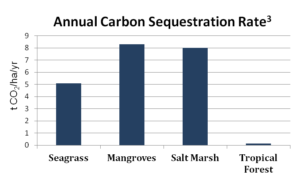Blue Carbon Science & Projects
Carbon Stored and Sequestered by Coastal Wetlands

Carbon is held in the above and below ground plant matter and within wetland soils. As plants grow, carbon accumulates annually and is held within soils for centuries. Science is increasing our understanding of how much carbon is sequestered (captured from the atmosphere via photosynthesis) and stored by wetlands.
Blue Carbon ecosystems – seagrass beds, mangroves, salt marshes, and other tidal wetlands – capture atmospheric carbon and store it in the ground at rates up to 10 times greater than forest on a per area basis. In forest habitats, the majority of carbon storage is in the above-ground plant material (think woody biomass). In contrast, the majority of carbon storage in wetlands occurs in the soils, where it can remain locked up for centuries or more1.
Why are wetlands soils such great carbon sinks? Because wetland soils stay wet, oxygen content in the soil is low. Lower oxygen means decomposition happens much more slowly, allowing organic material to build up over time. As long as these soils remain intact and wet, carbon remains locked up – making wetland soils amazing long-term carbon sinks!
When coastal wetlands are drained or degraded, the stored carbon can re-oxidize, releasing back into the atmosphere relatively quickly – sometimes releasing centuries worth of stored carbon in only a few decades. Protecting our remaining coastal wetlands also protects these large carbon stores, while continuing to provide many other benefits (improved water quality, storm protection, fisheries habitat, etc.) An estimated half a billion tons of CO2 are released every year due to wetland degradation and drainage – roughly equivalent to the 2008 emissions of Japan.
1Sources: E. Pidgeon. 2009. Carbon sequestration by coastal marine habitats: important missing sinks.
Carbon Storage
The largest store of carbon in wetland habitats is in the soil. In the first meter of soil, they contain:
- Seagrasses: 512 Mg CO2e/ha
- Salt marsh: 917 Mg CO2e/ha
- Mangroves: 1,028 Mg CO2e/ha

2Sources: Pendleton et al. 2012 and Pan et al. 2011
Carbon Sequestration
Wetland plants regularly remove CO2 from the atmosphere and sequester it in the form of soil carbon, where it can remain for centuries. Average carbon sequestration rates are several times greater than for forests:
Seagrasses: 138 ± 38 gC/m2/yr equal to 5.1 tCO2/ha/yr
Salt marsh: 218 ± 24 gC/m2/yr equal to 8.0 tCO2/ha/yr
Mangroves: 226 ± 39 gC/m2/yr equal to 8.3 tCO2/ha/yr

3Source: McLeod et al. 2011
Carbon Comparisons
- A Hummer driving 15,000 miles emits 11 tons of CO2e (carbon dioxide equivalents).
- A Prius driving 15,000 miles emits 3.7 tons of CO2e.
- While just one hectare (2.5 acres) of salt marsh removes an estimated 8 tons of CO2e every year.
Blue Carbon Estuary Assessments
A blue carbon estuary assessment typically includes an estimated carbon stock and sequestration value for an estuary. This can include field data collection and/or a synthesis of available data. These analyses serve as a first look at the blue carbon potential for a coastal wetland habitat, restoration or management activities.
Blue Carbon in Restored and Reference Salt Marshes | Galveston Bay, Texas
(August 2017)
This study compared carbon storage and capture in restored salt marshes versus natural salt marshes in Galveston Bay, Texas.
Tampa Bay Blue Carbon Assessment | Tampa, Florida
(June 2016)
The Tampa study assessed the climate mitigation potential of Tampa coastal habitat over the next 100 years and how sea-level rise will impact these habitats. The report also provides management recommendations for habitat adaptation.
The study found that Tampa coastal wetland habitats (including mangroves, salt marsh and seagrass) will remove over 73 million tons of CO2 from the atmosphere over the next 100 years. This is equivalent to taking 160,000 passenger cars off the road every year until 2100.
Coastal Blue Carbon Assessment for the Snohomish Estuary | Puget Sound, Washington
(Feb 2014)
The Snohomish Assessment took place in Puget Sound, WA and determined the climate mitigation benefits of estuary restoration.
The study found that currently planned and in-construction restoration projects in the estuary will result in at least 2.55 million tons of CO2 sequestered from the atmosphere over the next 100 years. This is equivalent to the 1-year emissions for 500,000 passenger cars. If plans expanded to fully restore the Snohomish estuary, the sequestration potential jumps to 8.9 million tons of CO2, equal to the 1-year emissions of about 1.7 million passenger cars.
This study was the first of its kind and provides much needed research for assessing carbon changes in wetland habitats and for determining wetland restoration potential to mitigation climate change. This approach can be applied to other estuaries.
Partner Projects
- Waquoit Bay National Estuarine Research Reserve — Bringing Wetlands to Market
- Conservation International (with IUCN and IOC) — Blue Carbon Initiative
- International Partnership for Blue Carbon
- Smithsonian Environmental Research Center — Coastal Carbon Research Coordinating Network
